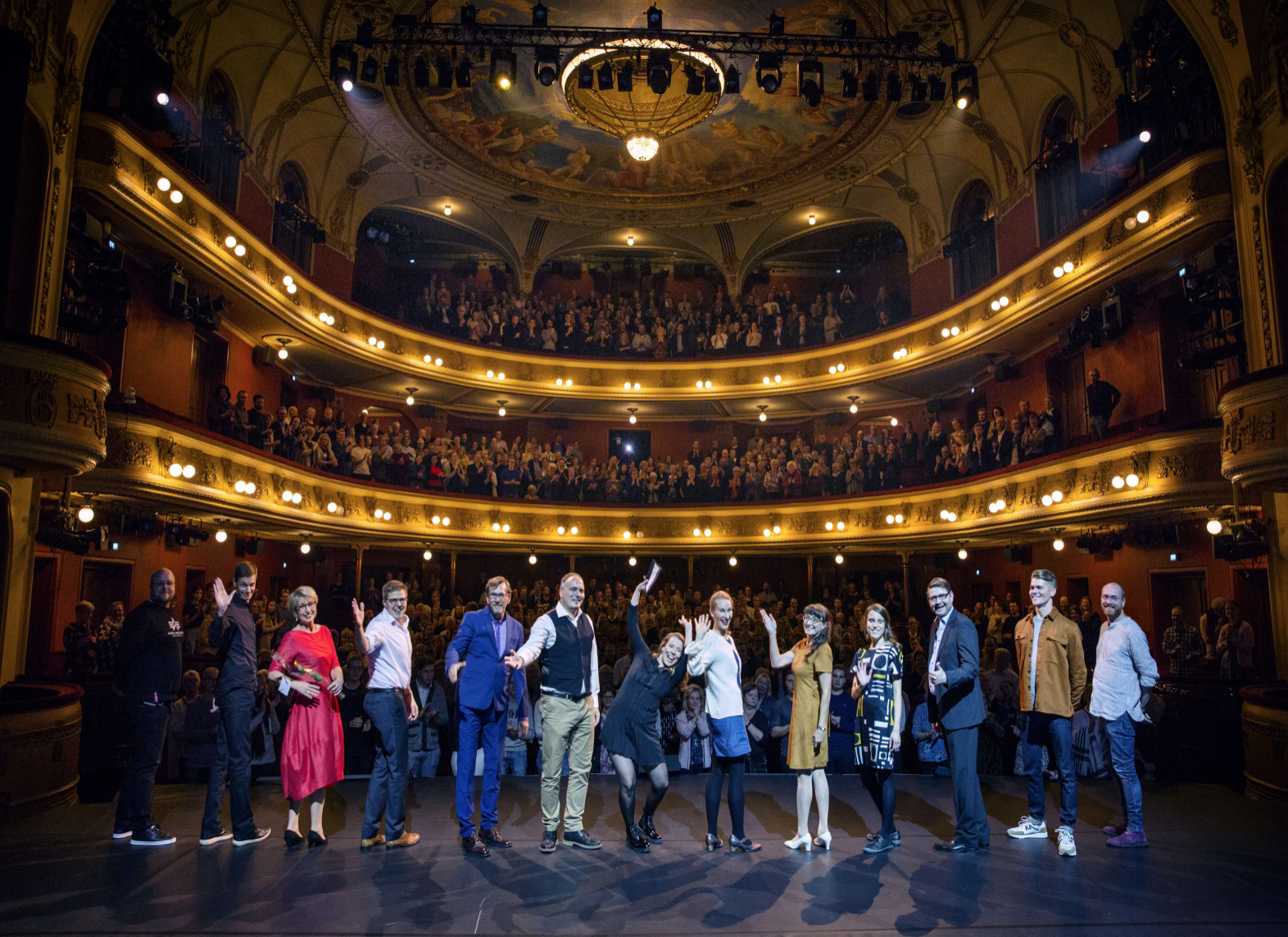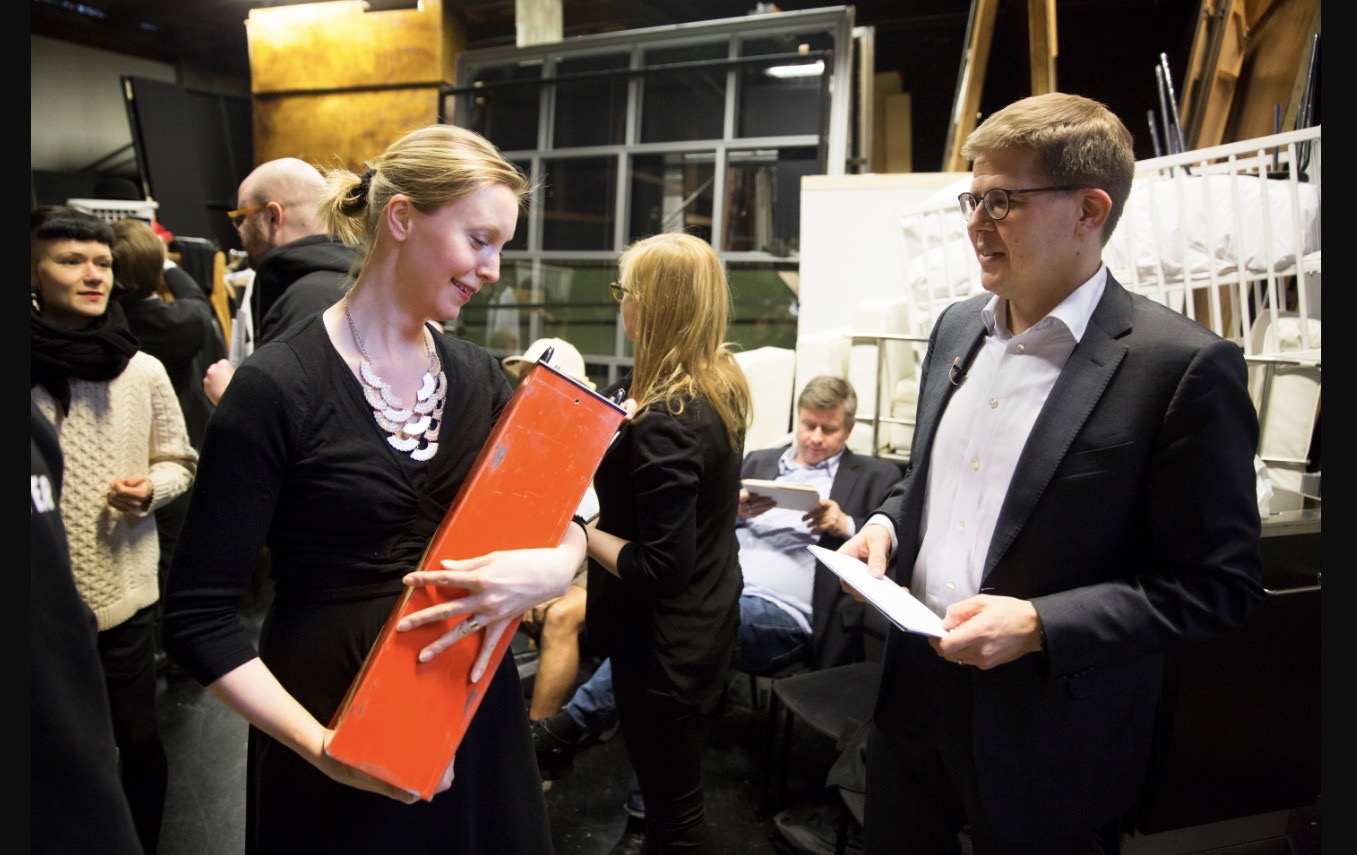In this piece
Pulling back the curtain: How 'live journalism' is re-engaging news audiences

Helsingin Sanomat’s Black Box was so successful it had to move to the main hall of the Finnish National Theatre in Helsinki. (Photograph: Erik Rehnstrand)
In this piece
It was a Thursday evening on 4 February 2016 and the atmosphere backstage at Finnish National Theatre was tense.
Journalists – not actors – milled around nervously backstage. The first Black Box (Musta laatikko) performance in history was about to begin.
Muted sounds filtered in from the sold-out auditorium as the audience found its seats. Some 300 people had bought a ticket to hear newspaper reporters tell a series of true-to-life stories. I was one of the producers and the opening night host. When the clock struck 7, I was pushed onstage.
“Welcome to the Black Box,” I said to the gathered faces. In my hands was a carrot-coloured metal object known as a ‘black box’ – a flight recorder from a DC-9 that preserves technical data several times per second. If an aeroplane falls from the sky, the black box can help investigators decipher exactly what happened. The name is in fact a misnomer, as the sensitive measuring device is in truth encased in a bright-orange metal shell.
Our team from Finland’s leading daily newspaper Helsingin Sanomat had christened the live journalism concept “Black Box” in homage to both the theatre space we were using and journalism’s basic mission: to decipher exactly what happened.
Black Box got its start in the autumn of 2015. I was sitting at my workstation tapping out a story one day, when a colleague named Riikka Haikarainen stopped by for a chat. She had recently returned to the Helsingin Sanomat newsroom from California, where she had been studying for a year on a stipend. During her stay, she had travelled to Los Angeles to attend a Pop-Up Magazine event. This was a live show where reporters, photographers and documentary filmmakers took to the stage to tell previously unpublished true stories. They called their performance “live journalism”.

“What if we tried the same thing?” Riikka suggested. We sat down with video producer Kimmo Norokorpi to contemplate the idea: what would our newspaper’s live performance be like? What would it contain? Where would it take place? How would we make it happen? Would Finnish residents be willing to pay money to watch a bunch of journalists from its most widely distributed daily tell stories on a stage?
We decided to give it a try, but not reveal our plans to the newspaper’s management. The media crisis had only barely begun to loosen its grip, and the bar for embarking on new projects was still high. We wanted to move quickly and lightly, in the spirit of experimentation, imagining ourselves a feisty internal start-up within a big company. We didn’t want to spend time fine-tuning something that might be brushed aside as an unrealistic pipedream. Our work became that of an undercover strike force: stealthily meeting to refine the concept, assemble a working group and brainstorm topics.
The underlying notion of the Black Box was to bring our newspaper to the theatre stage. In other words, the performance should resemble our publication, with sections devoted to domestic and international news, politics, the economy, culture, sports, lifestyle and science – just as it was laid out in the daily print paper or our website.
Once our concept was decided, we set out to find a venue. The director of the venerated Finnish National Theatre, Mika Myllyaho, was immediately enthused: “Great idea, let’s do it!” he said. We booked the theatre’s small stage for three evenings in the spring of 2016. The time had come to pitch our idea to the newspaper’s management. Fortunately, editor-in-chief Päivi Anttikoski’s eyes lit up as we explained our idea, and she told us to “Go for it!”
We had no instructions or manual to follow, so our journey was one of trial and error – sometimes even proceeding on blind faith. One month before our first performance, we put the tickets up for sale. We wrote a low-profile story for the paper and website with the headline “Helsingin Sanomat brings its journalism and reporters to the stage – series of live performances to begin in February”. Ticket sales began at 9 am. The 300 tickets available were sold out in less than an hour.
That spring we produced three different shows on the small stage of the Finnish National Theatre. In the autumn of 2016, we added additional shows, but the public was thirsty for more, as each of the performances sold out instantly. By the spring of 2017, we had to transfer to the theatre’s 700-seat main stage. Then our team hit the road, bringing Black Box to the Finnish cities of Turku and Tampere. In an effort to meet customer demand, we added even more performances. In the spring of 2018, our team was awarded a prize for Journalistic Invention of the Year – the most prestigious recognition in Finland.
We have staged 15 performances with different content over the span of the past four years, playing to more than 30,000 audience members. Close to 100 reporters and photographers from Helsingin Sanomat have participated in the presentations. Tens of thousands of subscribers to the paper watched livestreams of the events on the paper’s website.
Our covert experiment has since become an important part of the Helsingin Sanomat newspaper. Black Box has created a new kind of community around the esteemed publication. Audience feedback indicates that even the most hard-to-reach group of 15 years olds is in thrall to this revolutionary new form of news presentation. What we were witnessing is the phenomenal power of live journalism.
So what exactly is behind the appeal of live journalism? What kind of connection does it forge between journalists and the different audiences? How does one go about putting on such a show? My report seeks to answer these questions.
I received a grant from the Helsingin Sanomat Foundation to spend the academic year of 2019–2020 at the Reuters Institute for the Study of Journalism at the University of Oxford. I wanted to use this opportunity to take a deep dive into live journalism, which was clearly a rising global trend.
My report is not an academic study. I am not a researcher; I am a journalist. I have relied on the traditional journalistic methods of observation and interview in compiling this account. I attempt to explain the appeal of live journalism through my own experience as a producer and viewer. I do not pretend to be an objective observer. I am instead a journalist that has made it my job to thoroughly examine this new form of journalism. I am eager to share my findings and what I’ve learned with anyone who is interested.
I hope my report will serve as a travel guide or manual for journalists who wish to try this new and intriguing format.

